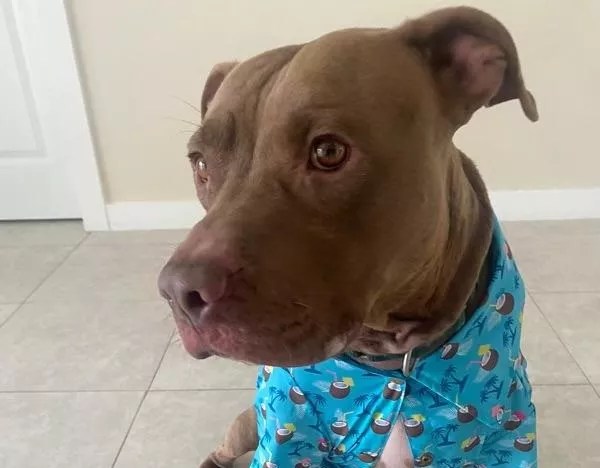
Photo by Sofia Valverde

Audio By Carbonatix
Some strays in Miami-Dade get lucky.
They’re sent to a polished, $15 million new county facility in Doral with air-conditioned kennels and a “community playroom for cats.” Local families file into its Pet Adoption & Protection Center with kids wide-eyed at the thought of bringing home a furry new friend.
Then, there’s a less fortunate group of mutts, misfits, and down-and-out pooches relegated to the Medley facility, the county’s old animal shelter that has no AC, no fancy greeting area, and a staff markedly slimmer than the Doral site’s crew. Roughly 140 dogs are housed at the location on NW 74th Street, the former headquarters of Miami-Dade Animal Services. The site is not open to the public, though dogs are available for adoption.
According to the county, the Medley site may not be glamorous, but it helps handle an unprecedented population of dogs in county custody. Miami-Dade Animal Services says the facility keeps a roof over dogs’ heads and minimizes the number of canines put to death.
“While many shelters, including our neighbors in West Palm Beach, are reporting that they are euthanizing animals due to lack of space, Animal Services is using every possible resource to care for pets and maintain our county’s lifesaving mission,” animal-services spokesperson Flora Beal tells New Times.
Good intentions notwithstanding, animal rights advocates are more than mildly peeved about the facility.
Sofia Valverde, founder of Picolini’s Animal Rescue, says the Medley facility is in a dilapidated state and needs immediate attention. When she recently visited, there was no staff responding onsite. She claims that overgrown grass and fences in disrepair did not inspire confidence that the place was being well maintained.
“The dogs were barking nonstop. I was there for a half hour trying to see if I could contact someone, but no one was there. The facilities are completely run down,” Valverde claims.
Valverde has adopted dogs from the Medley facility, and their medical records indicate a tick infestation at the property in July. One dog Valverde was monitoring had unexplained neck and ear wounds and suffered a respiratory infection while staying at the facility.
Sparking outrage and protests last month, a video Valverde took of the facility’s exterior was posted on social media, depicting the allegedly unattended dogs barking loudly in unison.
Miami-Dade County Mayor Daniella Levine Cava said in a statement in August that the Doral building was designed to take care of up to 300 dogs, but the county has been inundated with rescue animals and had more than 600 dogs in its custody. She described the Medley facility as “a critical tool to help prevent overcrowding that can cause disease, behavioral problems, and other major challenges.”
When it opened to much fanfare in 2016, the 70,000-square-foot Doral shelter was billed as one of the largest air-conditioned animal shelters in the nation. Its lobby has shiny floors, modern lighting, and a message in giant letters above the desk, “Connect, adopt, love.”
It was a new start for the county and a chance to leave the troubled past of the Medley site behind. (Dating back more than a decade, New Times chronicled rough times in Medley: a severe canine distemper outbreak in 2011, turmoil in management, and reports of unsafe application of cleaning chemicals that left dogs’ scrotums badly irritated.)
But Beal says the Medley site was never removed from the animal services portfolio.
She says the county “has nothing to hide” and that the Medley pets are being promoted for adoption on the county’s social media. As for rumors that volunteers are being turned away from the facility over fears of media leaks, Beal claims they’re bunkum.
“There’s a smaller staff there, so it is critical that we have the right volunteers out there who know dog behavior to make it safe for everybody. We are not going to send one of our teenage high school volunteers there,” Beal says.
By all accounts, the facility is used partly to quarantine sick canines. Once a dog recovers from disease, it has a chance to be relocated to the Doral facility as space permits.
Animal rights advocates question whether less desirable animals, namely large dogs with behavioral issues and canines from stigmatized bully breeds, are also being routed to Medley. The facility remains cut off from unscheduled adoption visits – no families waltzing in and ogling pooches as they do in Doral.

Miami-Dade County opened its sprawling Pet Adoption & Protection Center in Doral in 2016.
Photo by Miami-Dade County
While the county says it’s trying to rotate dogs at Medley into Doral whenever possible, Valverde maintains some animals are getting stuck in the AC-less facility for several months. She says she adopted one dog, Butterscotch, who had been caged in Medley for 200 days.
“Butterscotch was socially isolated for so long. She didn’t know how to interact with people,” Valverde says.
“I’m a founder of a rescue,” she says. “I want to talk about this, and I want people to get informed to be aware. We need to make a change, and I can use the dogs we pulled out – the condition and the psychological trauma that they endured.”
Miami-Dade County Animal Services insists the backlash last month was unwarranted. This summer, the department invited media crews into the Medley site on scheduled visits to show reporters how the kennels are cleaned and fans are running to try to cool down the pets during the record summer heat in Miami.
“Veterinary staff make daily rounds to provide medical treatment and ensure the well-being of the shelter pets. Animal Care Specialists are stationed at the facility to clean kennels and provide care to our shelter pets; all animals are provided clean water and fed twice per day,” Beal tells New Times.
Animal Services’ budget has ballooned in recent years, and annual expenditures climbed from nearly $24.4 million in fiscal year 2016-17 to $29.7 million for 2021-22. Most of the funding comes from the countywide general fund, with only a small portion coming from fees generated from shelters.
The department said in a 2022 report that it had achieved a “no-kill” classification every year since 2015, meaning no more than ten percent of rescued animals were euthanized.
These days, the county takes in roughly 30,000 dogs and cats in a year.
Valverde claims the Medley dogs are not being walked enough and have little human interaction, which could lead to problems bonding once they are adopted. The county has bitten back, saying workers and volunteers regularly visit to tend to the animals, walk them, and provide twice-a-week sessions for playgroups and exercise.
Mayor Levine Cava recently attributed the spike in homeless cats and dogs to increased cost of living and housing insecurity among pet owners. In a Miami Herald op-ed, she promoted the county’s upcoming MEGA adoption event on October 21 and said she is looking to allot an additional $2 million to expand animal services.
The county has been imploring the public to step in and adopt a dog to help ease the shelter overcrowding crisis that has afflicted South Florida, from Palm Beach County to Miami.
“We want to make sure the community is hearing our pleas,” Beal says.